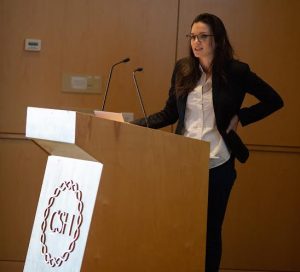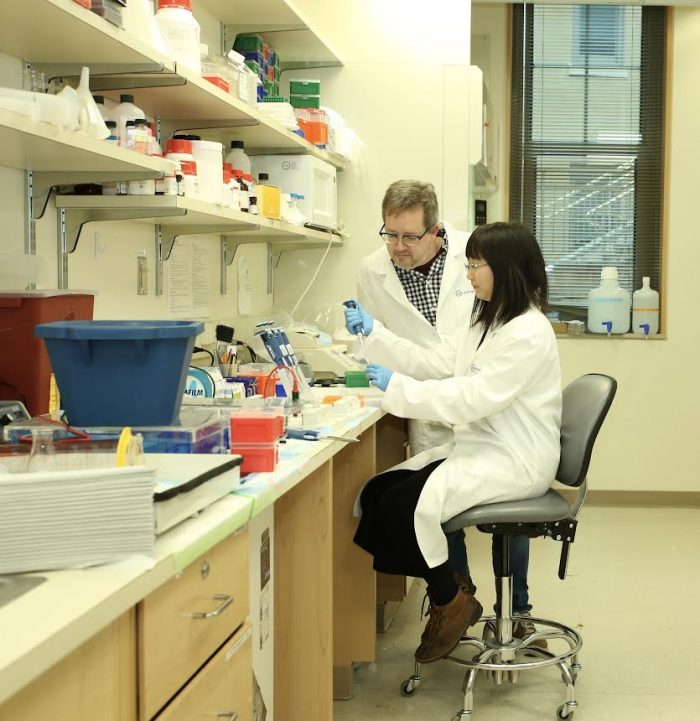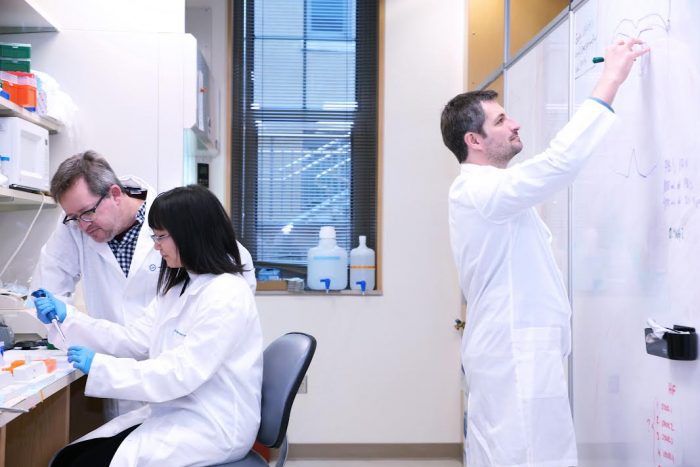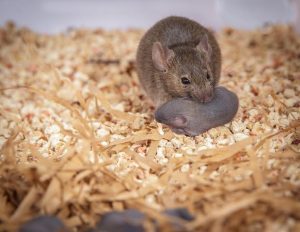By Daniel Dunaief
The DNA Learning Center at Cold Spring Harbor Laboratory doesn’t just provide educational opportunities for students; it can also inspire their teachers.
That was the case for PhD graduate Alexandra Nowlan, who worked in the lab of Professor Stephen Shea.
When Nowlan met her required teaching component at the center as a part of the graduation requirement for her doctorate, she found educating the next generation inspiring.
“It’s very rewarding to get kids excited about science,” said Nowlan.

Indeed, Nowlan, who did her postdoctoral work at the University of North Carolina at Chapel Hill in the Bowles Center for Alcohol Studies, has taken a job as assistant teaching professor in the Department of Psychology and Neuroscience at the same institution. She is teaching two neuopsychopharmacology classes and is preparing for an advanced molecular pharmacology class in the fall.
“I was really drawn to outreach opportunities and put more of my focus into teaching,” she said. “The opportunity presented itself, so I jumped at it. I’m having a really good time.”
Established in 1988, the DNA Learning Center was the first site to focus on genetic education for the public, offering classes to students in 5th through 12th grades.
The Learning Center, with sites in five different locations in New York, provides classes and labs for 30,000 students each year.
Amanda McBrien, Assistant Director of the DNA Learning Center, observed Nowlan in action.
“She had a magnetic energy about her,” said McBrien. “She came in and was young, enthusiastic and cool all wrapped into one.”
During a Fun with DNA course in the summer offered in conjunction with Women in Science, Nowlan was the “perfect role model,” McBrien added, who proved to be “utterly approachable” and enthusiastic, making her an engaged presenter.
Students can find information about these classes through the DNA Learning Center and can register for summer courses starting this week.
Recent publication
In addition to her professional journey into teaching, Nowlan recently published the results of a study she conducted in the journal Current Biology based on research conducted at CSHL.
Working with Shea and other scientists who followed her in Shea’s lab, Nowlan studied the way the mouse brain processes sensory signals such as odor and sound as a part of a pup retrieval process.
Important in the behavior of mothers and of surrogates who care for the young, pup retrieval helps ensure that developing mice stay closer to their mothers or caretakers.
“Pup retrieval is one of the most important things for mothers or caregivers,” Shea said in a statement. “It requires the ability to smell and hear the pup. If these things are both important, that may mean they merge somewhere in the brain.”
Indeed, during pup retrieval, neurons from an area of the brain called the basal amygdala carry smell signals to the auditory cortex, which is the brain’s hearing center. The basal amygdala is involved in learning and processing social and emotional signals, linking perception with emotion and social learning.
When Nowlan and others blocked the ability of maternal mice to access smell signals, the mice didn’t provide their customary parental pup retrieval.
Shea and his lab suspect that what’s reaching the auditory cortex is being filtered through social-emotional signals from basal amygdala neurons.
“We’ve known that pup odor is important,” said Nowlan. “People have eliminated odors and seen deficits.”
Deficits in vocalizations also can affect this behavior.
“The pathway that would allow olfactory signals to reach the auditory cortex was unknown and we’ve identified a pathway that is functionally capable of linking those two senses,” Nowlan explained.
A winding path
Nowlan, who grew up in Williamstown, Massachusetts, played rugby in college at the University of Massachusetts at Amherst. While three concussions encouraged her to search for a non-contact sport, it also piqued her interest in neurology.
After she graduated, she worked for four years in the laboratory of Sandeep Robert Datta at Harvard Medical School, where she learned about the importance of the olfactory system.
At the Datta lab, she worked with then postdoctoral researcher Paul Greer, who let a flier on her desk about Cold Spring Harbor Laboratory’s graduate program.
“The umbrella program appealed to me,” she said. “You could get an education not only in the subject you’re interested in but you also had an opportunity to learn about cancer biology and plant genetics, which was exciting.”
Nowlan attended courses and meetings, interacting with top scientists across a range of fields.
The first year she lived in a house on campus near the water, where she and her fellow graduate students could see the lights of all the buildings at night.
“My classmates and I felt like we were at Hogwarts, this magical science camp,” she said.
Postdoctoral transition
When she was writing her PhD thesis, Nowlan became interested in motivated behaviors.
She had been following reports about the opioid epidemic and knew it was affecting Berkshire County, where she grew up.
She was curious about how opioid use disrupted noradrenaline signaling, which plays an important role in motivation, rewarding and the body’s stress response.
“I wanted to explore how these motivational circuits can get disrupted in examples where drugs that are commonly misused are involved,” she said.
She and others in the lab of Zoe McElligott at the Bowles Center were trying to understand various brain circuits as people undergo the painful experience of addiction withdrawal.
More information about these processes could reduce the negative experience and lead to better and perhaps more effective treatments.
Born on the same day
Nowlan met her husband Craig Jones, a Long Island native, through a dating app.
“I joked when we first met that the algorithm” from the app that brought them together was lazy, she said. They were both born on the same day, just hours apart.
Jones, who works as a user experience designer for fitness company Zwift, is “older and he won’t let me forget it,” said Nowlan.
As for her current teaching role, Nowlan is hoping to emulate the inspirational approach of Enrique Peacock-López, a college professor at nearby Williams College. In addition to coaching a soccer team with his daughter and Nowlan, Enrique-López took time to share chemistry demonstrations in primary school and to bring high school students into his lab.
Nowlan appreciated how Peacock-López connected with students.
“The way he made science exciting and accessible to members of the community is really inspiring,” said Nowlan.
Peacock-López has known Nowlan for decades.
“There’s a lot of satisfaction that I may have contributed a little bit with my grain of salt in their careers,” said Peacock-López. When he teaches, he seeks ways to motivate students to solve problems.
For younger children as a starter experiment, he works with reagents that reveal considerable color or that has fumes.
“They love to hear sounds or see colors,” he said.
Peacock-López’s advice to future teachers is to “interact with students” and get to know them.
A native of Mexico, he promised himself when he started teaching that he would treat students the way he would want to be treated.
As for Nowlan, she is eager to continue the teaching tradition.
“It makes me want to keep giving back and provide opportunities to educate the public about what we’re doing and why it’s interesting and important,” Nowlan said.
Her goal is to educate the next generation of neuroscientists and curious community members about how discoveries made in the lab are translated into treatments for disease.








